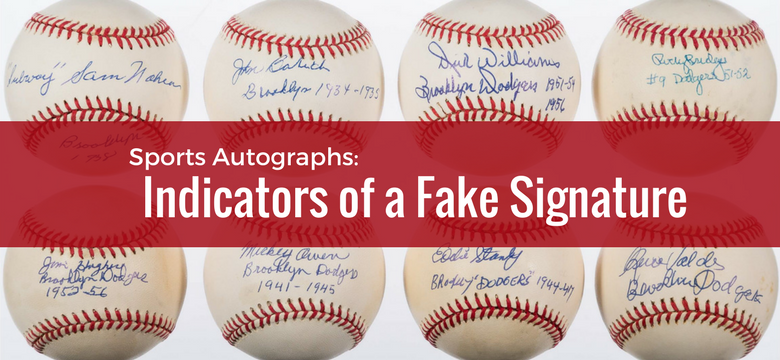Autographs mean different things to different people. For some, they are reminders of chance encounters with childhood heroes, or of hours spent waiting to meet – even if only for a couple of seconds – a favorite athlete or entertainer. They also can be prized possessions, treasured gifts or shrewd investments.
They also can be fake.
Buy, Value or Appraise Your Sports Autographs and Memorabilia
Bid or buy sports memorabilia for sale, value your item, or request a free appraisal to sell your collection.
How to Tell a Fake Sports Autograph
The validity of an autograph sometimes is beyond doubt. Watch the person sign in person and the authenticity is iron-clad. When showing the autograph, especially to a potential buyer, an accompanying photo or video of the signing definitely goes a long way toward strengthening the provenance. If those options aren’t available, buying autographs with paperwork from leading authenticators increases the chance that the autograph is genuine.
Sports autographs are a big business, which unfortunately means there are those out there who will present something for sale that is not what the seller claims. If you buy or receive an autographed item, look it up to compare it against verified signatures by the same person. If it clearly doesn’t match verified autographs from the same person, the answer is disappointing but clear. However, some fakes are very good, even to someone with a discerning eye. They can be written – well – by other people including agents, equipment managers, team office personnel or sometimes printed with a stamp. The first step always is to take any autograph you did not personally witness being signed to an expert for authentication.
Especially in regard to sports autographs, there are certain indicators that an untrained eye can spot which can raise red flags that merit more thorough investigation:
- Check the location of an autograph in relation to a baseball’s stitches. If a signature creeps into the stitches, chances are good that it was stamped or done with an autopen. Pens do not sign smoothly over stitches, especially if the stitches are raised to a significant height and/or in stark contrast to the surface of the ball, and even if they could, it is highly unlikely that anyone would sign that way.
- An autograph on a ball from any sport – baseball, football, basketball, etc. – often will be on an official or regulation ball. Yes, there are times when athletes and coaches sign replica or commemorative balls, but most real balls are stamped somehow, either with the logo of the manufacturer (Wilson, Spalding, etc.), a specific model of the ball or even the name of an athlete who has commercially endorsed it. One easy way to identify a stamped signature is the absence of a manufacturer’s mark. Almost no baseballs have been made without a maker’s mark, and discerning between regulation and retail balls is a distraction, since the only significant difference is the fact that regulation and retail balls have the maker’s mark that stamped balls lack. Beyond that, the only difference, in terms of authentication, is that unsigned regulation or retail balls from decades ago are difficult to find; therefore, many forgeries of now-dead players appear on non-official balls.
- Another indicator is the color of ink used on any autograph. Not all balls written in black ink are stamped, but almost all stamped balls are written in black ink.
- Stamped balls usually are team balls, rather than those carrying single autographs. But team balls that are not stamped are less likely to be fakes than single-signed balls, because it is tougher to fake the signatures of an entire team, or group of players, than to mimic a single autograph.
All of these are not meant to discourage autograph collectors; on the contrary, this is intended to help collectors acquire what they think they are getting when they plunk down their money. More than anything, unless you personally watch someone sign before handing an item directly to you, it always is best to get it appraised by an expert.
Written by: Steve Lansdale
